Ara (bird)
| Ara | |
|---|---|
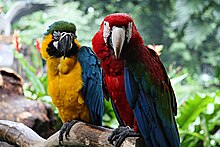
| |
green-winged macaw (right) at Jurong Bird Park , Singapore
| |
| Scientific classification | |
| Domain: | Eukaryota |
| Kingdom: | Animalia |
| Phylum: | Chordata |
| Class: | Aves |
| Order: | Psittaciformes |
| Family: | Psittacidae |
| Tribe: | Arini |
| Genus: | Ara Lacépède, 1799 |
| Type species | |
| Ara macao (scarlet macaw) Linnaeus, 1758
| |
| Species | |
|
See text | |
Ara is a
The Ara macaws are large striking parrots with long tails, long narrow wings and vividly coloured
Taxonomy
The genus Ara was erected by the French naturalist
There are eight surviving species, two extinct species that died out during modern times, and a third extinct species known only from
Several
Morphology and appearance

The Ara macaws are large parrots ranging from 46–51 cm (18–20 in) in length and 285 to 287
The colours in the plumage of the Ara macaws are spectacular. Four species are predominantly green, two species are mostly blue and yellow, and three species (including the extinct Cuban macaw) are mostly red. There is no sexual dimorphism in the plumage, and the plumage of the juveniles is similar to adults, although slightly duller in some species.[7]
Distribution and habitat
The Ara macaws have a
and several hypothetical species apparently became extinct in the islands of the Caribbean.The Ara macaws are generally fairly adaptable in their habitat requirements; this reaches its extreme in the scarlet macaw, which as suggested in its widespread distribution, uses most habitat types from humid
Within their range, birds may travel widely seasonally in search of food. They do not undertake large scale migrations, but instead more local movements amongst a range of different habitats.
Feeding and diet

Like all macaws and most parrots,
Breeding
Like almost all parrots, the Ara macaws are cavity
Species
| Ara | |||
|---|---|---|---|
| Common and binomial names[14] | Image | Description | Range[15] |
| Great green macaw or Buffon's macaw (Ara ambiguus) |
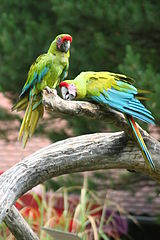 |
85–90 cm (33–36 in) long. Mostly green, red on forehead, green and blue wings[16] | Central and South America, from Honduras to Ecuador |
| Blue-and-yellow macaw or blue-and-gold macaw (Ara ararauna) |
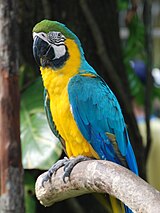 |
80–90 cm (31.5–35.5 in) long. Mostly blue back and yellow front. Blue chin and green forehead. The upper zone of the bare white skin around each eye extending to the beak is patterned by lines of small dark feathers. | Miami-Dade County, Florida
|
Green-winged macaw or red-and-green macaw (Ara chloropterus) |
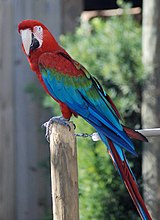 |
90 cm (36 in) long. Mostly red, with blue and green wings. The bare white skin around each eye extending to the bill is patterned by lines of small red feathers. | South America, from Colombia through to northern Paraguay (formerly northern Argentina) |
| Blue-throated macaw (Ara glaucogularis) |
 |
75–85 cm (30–34 in) long. Blue upperparts and mostly yellow lowerparts, blue throat. Areas of pale skin on the sides of the face are covered with lines of small dark-blue feathers, with pinkish bare skin at the base of the beak.[17] | North Bolivia |
| Scarlet macaw (Ara macao) |
 |
81–96 cm (32–36 in) long. Mostly bright red, with red, yellow and blue in the wings. There is bare white skin around the each eye extending to the bill. | Mexico to Colombia and the Amazon Basin. |
| Military macaw (Ara militaris) |
 |
70 cm (28 in) long. Mostly green, red forehead[18] | Discontinuous distribution in Mexico and along the Andes from Venezuela to north Argentina. |
| Red-fronted macaw (Ara rubrogenys) |
 |
55–60 cm (21.5–23.5 in) long. Mostly green. red forehead and red patch over the ears, pinkish skin on the face, red at bend of wings, blue primary wing feathers[19] | Central Bolivia |
| Chestnut-fronted macaw or severe macaw (Ara severus) |
 |
46 cm (18 in) long. Mostly green, chestnut forehead, red at bend of wings | Panama and South America in the Chocó and Amazon Basin
|
| †Cuban macaw (Ara tricolor) Extinct ca. 1885 |
 |
50 cm (20 in) long. Red forehead fading to orange and then to yellow at the nape of the neck, dark brown bill paler at the tip; orange face, chin, chest, abdomen and thighs; upper back mainly brownish red, and the rump and lower back blue; brown, red and purplish-blue wing feathers; upper surface of the tail was dark red fading to blue at the tip, and brownish red underneath.[20] | Extinct - formerly endemic on Cuba and probably also on Isla de la Juventud (previously called the Isle of Pines).[20] |
| †St. Croix macaw (Ara autocthones) Extinct |
 |
Only known from sub-fossil bones found at two archeological sites.[21] | Extinct - Saint Croix, U.S. Virgin Islands and central Puerto Rico |
Hypothetical extinct Ara
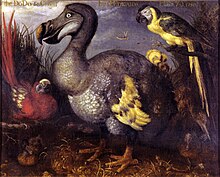
Macaws are known to have been transported between the
In addition to the three species known from remains, several hypothetical extinct Ara macaws were only based on contemporary accounts, but are considered dubious today. Many of these were named by
Other species have been mentioned as well, but many never received
| Hypothetical extinct species | |||
|---|---|---|---|
| Common and binomial names | Image | Description | Range[26] |
| † Jamaican green-and-yellow macaw or red-headed green macaw (Ara erythrocephala) Extinct |
 |
Length unknown. Red head, bright green body, blue wings and blue greater coverts. Scarlet tail and blue on top, and the tail and wings were intense orange-yellow underneath.[30] | Jamaica |
| †Jamaican red macaw or Gosse's macaw (Ara gossei) Extinct |
 |
Length unknown. Similar to the Cuban red macaw, but with a yellow forehead.[31] | Jamaica |
| †Martinique macaw (Ara martinicus) Extinct |
 |
Length unknown. Blue with an orange-yellow chest.[32] | Martinique |
| †Dominican green-and-yellow macaw (Ara atwoodi) Extinct |
 |
Length unknown. Green, yellow and red. | Dominica |
| †Lesser Antillean macaw or Guadeloupe macaw (Ara guadeloupensis) Extinct |
 |
Not known if it existed. Tail feathers 15–20 inches long. Similar colour as the scarlet macaw, but smaller with an entirely red tail. Known from descriptions and possibly paintings and subfossils. | Guadeloupe |
See also
References
- ^ a b "Zoological Nomenclature Resource: Psittaciformes (Version 9.004)". www.zoonomen.net. 2008-07-05.
- ^ Lacépède, Bernard Germain de (1799). "Tableau des sous-classes, divisions, sous-division, ordres et genres des oiseux". Discours d'ouverture et de clôture du cours d'histoire naturelle (in French). Paris: Plassan. p. 1. Page numbering starts at one for each of the three sections.
- ^ Ridgway, Robert (1916). "Genus Ara (Lacépède)". The Birds of North and Middle America. Bulletin of the United States National Museum. Volume 50, Part 7. Washington. p. 119.
{{cite book}}: CS1 maint: location missing publisher (link) - ^ Peters, James Lee, ed. (1937). Check-list of Birds of the World. Vol. 3. Cambridge, Massachusetts: Harvard University Press. p. 180.
- ISBN 978-1-4081-2501-4.
- ^ ISBN 978-0-670-81787-0.
- ^ ISBN 978-0-7153-7698-0.
- .
- ^ Plair, B.L., Lal, M., Ramadhar, A., and Ramsubage, S. 2013. Status of Blue-and-yellow Macaws Ara ararauna Reintroduced to the Nariva Swamp, Trinidad and Tobago. Living World, Journal of The Trinidad and Tobago Field Naturalists' Club, 2013, 19-28.
- S2CID 44060902.
- S2CID 4404459.
- ISBN 84-87334-22-9, pp. 420-425
- ^ Lanning, D (1991). "Distribution and breeding biology of the Red-fronted Macaw" (PDF). Wilson Bulletin. 103 (3): 357–365.
- ^ "Psittaciformes (Version 9.004)". Zoonomen: Zoological Nomenclature Resource. 2008-07-05.
- ISBN 84-87334-22-9pp.420-425
- ^ "Species factsheet: Ara ambiguus". BirdLife International (2008). Retrieved 24 July 2008.
- ^ "Species factsheet: Ara glaucogularis". BirdLife International (2008). Retrieved 24 July 2008.
- ^ "Species factsheet: Ara militaris". BirdLife International (2008). Retrieved 24 July 2008.
- ^ "Species factsheet: Ara rubrogenys". BirdLife International (2008). Retrieved 24 July 2008.
- ^ ISBN 978-0-670-81787-0.
- ^ Olson, Storrs L.; Edgar J. Máiz López (2008). "New evidence of Ara autochthones from an archeological site in Puerto Rico: a valid species of West Indian macaw of unknown geographical origin (Aves: Psittacidae)" (PDF). Caribbean Journal of Science. 44 (2): 215–222.
- ^ S2CID 54593515. Archived from the original(PDF) on 2011-07-25. Retrieved 2012-12-31.
- .
- S2CID 18597644.
- ^ ISBN 978-0-8493-2001-9. Archived from the original(PDF) on 2014-02-07.
- ^ a b Rothschild, W. (1907). Extinct Birds (PDF). London: Hutchinson & Co.
- ISBN 978-1408157251.
- ^ Wiley, J. W.; Kirwan, G. M. (2013). "The extinct macaws of the West Indies, with special reference to Cuban Macaw Ara tricolor". Bulletin of the British Ornithologists' Club. 133: 125–156.
- S2CID 87386694.
- ^ "Species factsheet: Ara erythrocephala". The Extinction Website (2008). Archived from the original on 13 October 2008. Retrieved 4 October 2008.
- ^ "Species factsheet: Ara gossei". The Extinction Website (2008). Archived from the original on 12 October 2008. Retrieved 4 October 2008.
- ^ "Species factsheet: Ara martinica". The Extinction Website (2008). Archived from the original on 2 October 2008. Retrieved 5 October 2008.
